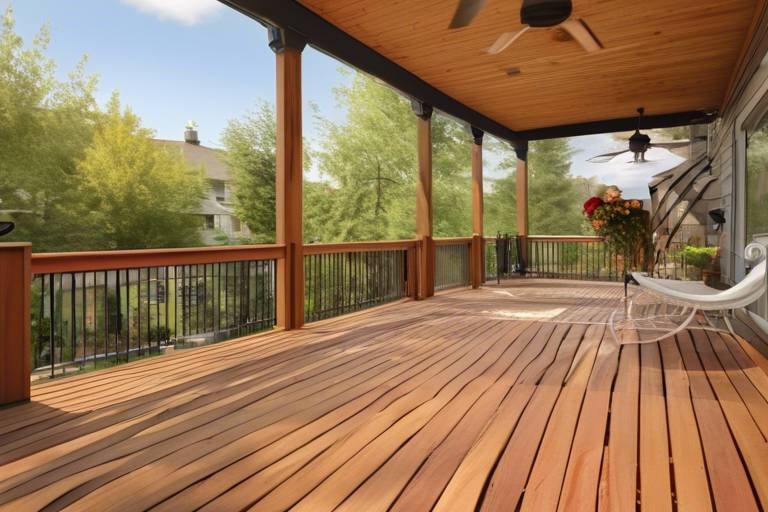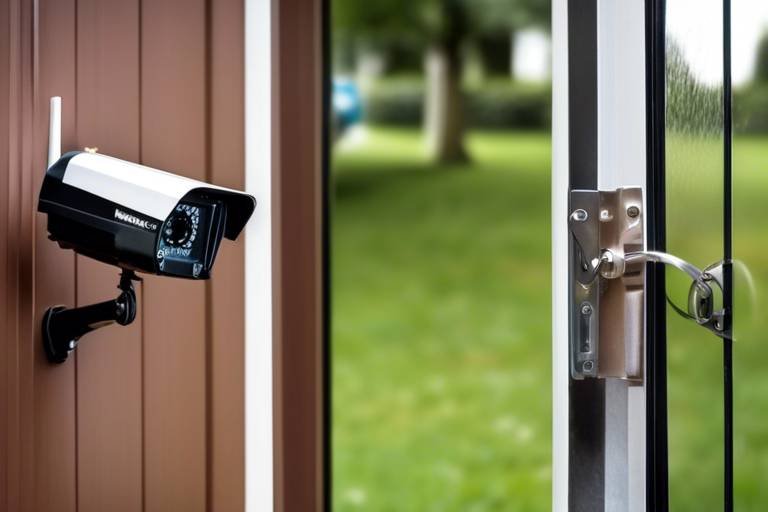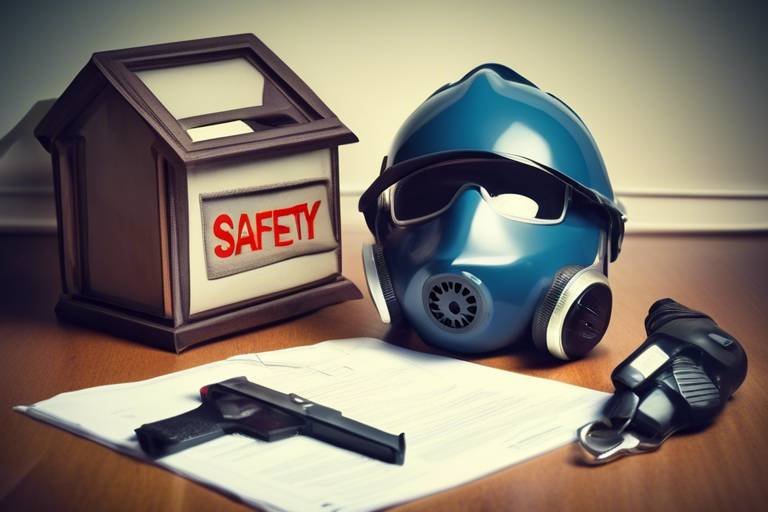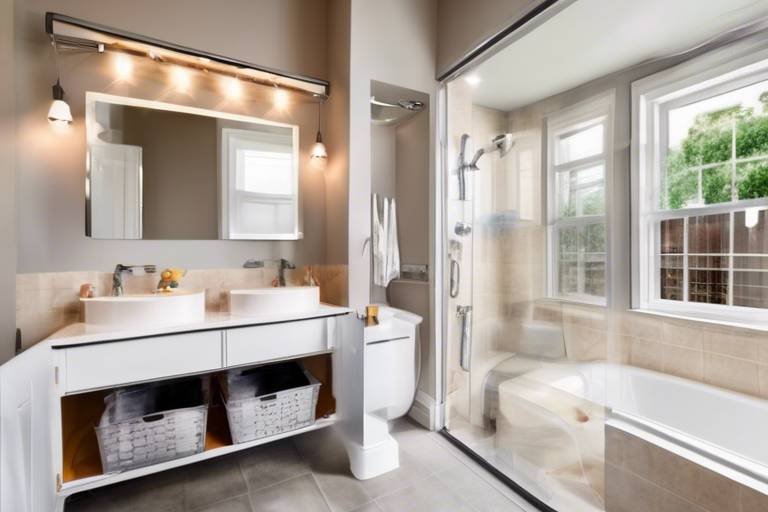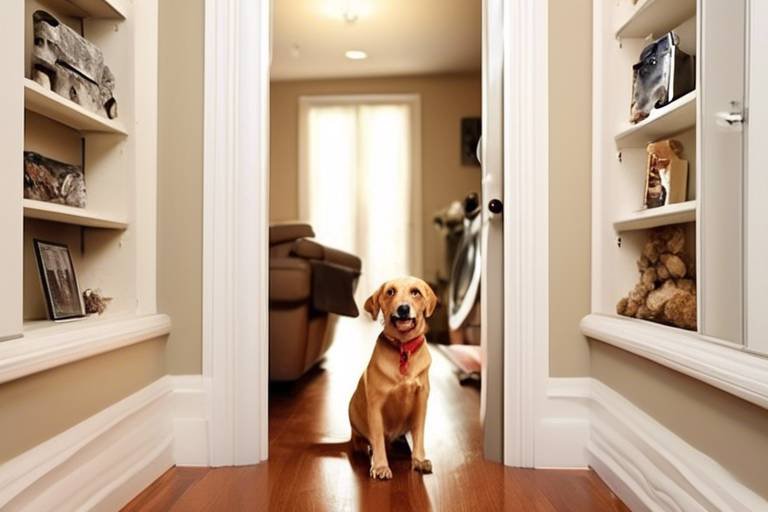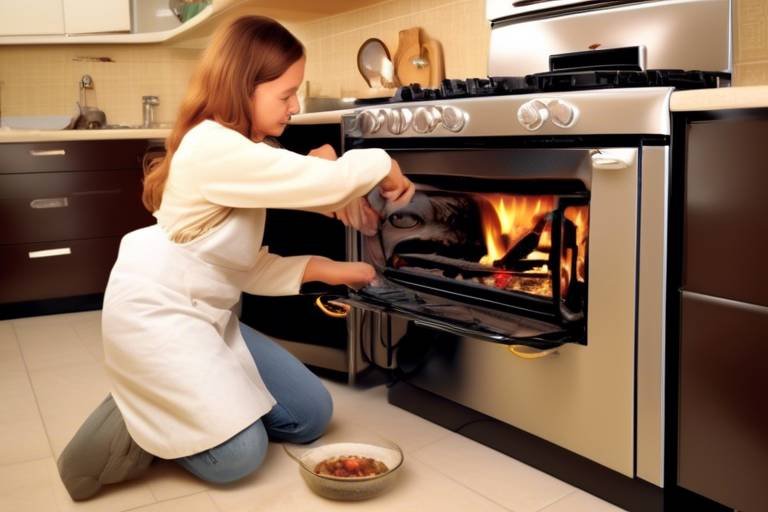Improving the Safety of Your Patio or Deck
When it comes to enjoying the outdoors, your patio or deck should be a haven of relaxation and fun. However, it’s crucial to recognize that safety should always be a top priority. Whether you’re hosting a summer barbecue, enjoying a quiet evening under the stars, or simply soaking up the sun, ensuring a secure environment for your family and friends is essential. In this article, we’ll explore practical tips and strategies to enhance the safety of your outdoor spaces. So, let’s dive in and make your patio or deck a safer place to unwind!
The first step in improving safety is identifying potential hazards that may lurk in your outdoor space. Common risks associated with patios and decks can range from unstable surfaces to inadequate lighting. Take a moment to walk around your patio or deck and consider the following:
- Are there any loose or damaged boards?
- Is the surface slippery, especially when wet?
- Are there any obstacles that could cause trips or falls?
- Is there enough lighting for nighttime use?
Recognizing these areas needing attention will help you create a safer environment. Remember, a little vigilance can go a long way in preventing accidents!
Selecting the right materials for your patio or deck can significantly impact safety. Not only do you want materials that look great, but you also need those that enhance durability and reduce the risk of accidents. Let’s explore some options that can help you achieve this.
One of the most critical aspects of outdoor safety is ensuring that your surfaces are slip-resistant. Slips and falls can happen in the blink of an eye, especially during wet weather. Consider materials like:
- Textured concrete
- Composite decking with grip
- Natural stone with a rough finish
These materials provide better traction and can help prevent accidents, making your outdoor space safer for everyone.
Textured finishes can significantly improve grip and reduce slips. For instance, applying a textured coating to your existing patio surface can create a more secure walking area. Options like stamped concrete or pavers with a rough texture can offer both aesthetic appeal and safety benefits.
If you’re looking for a quick fix, applying non-slip coatings to your existing surfaces can be an effective solution. These coatings are designed to enhance grip without altering the appearance of your deck or patio. When applying these coatings, ensure you follow the manufacturer’s instructions for the best results.
Weather-resistant materials are another crucial component of a safe patio or deck. They not only prolong the life of your outdoor space but also help prevent hazards associated with moisture, UV rays, and temperature fluctuations. Look for materials such as:
- Composite decking that resists fading and warping
- Aluminum railings that withstand rust and corrosion
- Weather-treated wood that can endure the elements
By investing in weather-resistant materials, you’ll ensure that your outdoor space remains safe and inviting for years to come.
Routine maintenance is essential for safety. Just like you wouldn’t ignore a check engine light in your car, you shouldn’t overlook the condition of your patio or deck. Regularly inspecting and maintaining your outdoor space can prevent hazards from arising. Here are some key practices to keep in mind:
Creating an inspection checklist can streamline your maintenance efforts. Regularly check for:
- Loose boards or railings
- Signs of mold or mildew
- Debris accumulation
- Damaged lighting fixtures
This proactive approach can help you catch issues before they become serious problems.
Regular cleaning and upkeep can prevent the buildup of debris and hazards. Schedule a routine cleaning of your patio or deck to remove dirt, leaves, and other materials that can create slippery surfaces. Consider using a pressure washer for a deep clean, and don’t forget to check for any signs of wear or damage while you’re at it!
Incorporating safety features can enhance protection in your outdoor space. By adding elements like railings, gates, and lighting, you can significantly reduce the risks associated with your patio or deck. Let’s take a closer look at some of these safety installations.
Railings and barriers are vital for preventing falls, especially on elevated decks. When selecting railings, consider various styles and materials that not only provide safety but also complement your outdoor decor. Look for options that are sturdy and meet local building codes to ensure maximum safety.
Proper lighting can prevent accidents during nighttime use. Installing lights along pathways, steps, and around seating areas can greatly enhance visibility. Consider using solar-powered lights for an eco-friendly solution that requires minimal maintenance. With the right lighting, you can enjoy your outdoor space safely, even after the sun goes down!
Q: How often should I inspect my patio or deck for safety hazards?
A: It’s best to inspect your patio or deck at least once a season, but more frequent checks after storms or heavy use are advisable.
Q: What are the best materials for a slip-resistant surface?
A: Textured concrete, composite decking with grip, and natural stone with a rough finish are excellent options for slip resistance.
Q: How can I improve lighting on my deck?
A: Consider installing solar-powered lights along pathways and steps, and use string lights for ambiance while enhancing visibility.

Assessing Current Safety Hazards
When it comes to ensuring the safety of your patio or deck, the very first step is to identify potential hazards. Think of this process as a treasure hunt, where the treasures are the hidden dangers lurking in your outdoor space. It’s easy to overlook these issues, especially when you’re busy enjoying a sunny day or hosting a barbecue. However, taking the time to assess your area can save you and your loved ones from potential accidents. So, what should you be on the lookout for?
Common safety hazards include:
- Uneven surfaces: Cracks, holes, or uneven tiles can be trip hazards, especially for children and the elderly.
- Loose railings: If your deck has railings, ensure they are sturdy and well-attached. A loose railing can lead to falls.
- Debris accumulation: Leaves, dirt, and other debris can make surfaces slippery, particularly when wet.
- Weather-related wear: Over time, exposure to rain, sun, and snow can deteriorate materials, leading to unsafe conditions.
To effectively assess these hazards, consider walking through your patio or deck with a keen eye. Look for any signs of wear and tear, and don’t hesitate to get down on your hands and knees to inspect the surfaces closely. You might be surprised at what you find! Additionally, you can create a simple inspection checklist to help you keep track of potential issues. This can include items like:
| Inspection Item | Frequency | Notes |
|---|---|---|
| Check for cracks in surfaces | Monthly | Fill or repair as needed |
| Inspect railings | Every 3 months | Ensure they are secure |
| Clear debris | Weekly | Prevent slipping hazards |
| Check for mold or mildew | Monthly | Clean with appropriate solutions |
Once you've identified these hazards, it’s time to prioritize them. Some issues may require immediate attention, while others can be scheduled for later. Think of it as a game plan for safety! Remember, the goal is to create an environment where you can relax and enjoy the outdoors without worrying about potential accidents.
In summary, assessing current safety hazards on your patio or deck is not just a chore; it's an essential part of maintaining a secure outdoor space. By being proactive and vigilant, you can turn your outdoor area into a haven of safety and enjoyment for everyone. So, grab that checklist and start your assessment today!

Choosing Safe Materials
When it comes to enhancing the safety of your patio or deck, choosing the right materials is crucial. The materials you select can make a significant difference in not only the durability of your outdoor space but also in the overall safety for your family and friends. Imagine hosting a summer barbecue, laughter filling the air, but suddenly someone slips on a wet surface—now that’s a party spoiler! To avoid such mishaps, let’s dive into some materials that can help create a safer environment.
First up, we have slip-resistant surfaces. These are essential, especially if your patio or deck is exposed to rain or moisture. A surface that provides better traction can mean the difference between a fun day outdoors and a trip to the emergency room. Some popular options include textured concrete, rubber pavers, and composite decking with a non-slip finish. Each of these materials can help keep your footing secure, even when the weather isn’t cooperating.
Slip-resistant surfaces come in various forms, and they are designed specifically to enhance grip. Think of them as the superhero of your outdoor space—always ready to prevent accidents. For instance, textured finishes not only look great but also serve a functional purpose. They are designed to provide extra grip, making it harder to slip. Additionally, non-slip coatings can be applied to existing surfaces, offering an easy and effective way to boost safety without the need for a complete overhaul.
Textured finishes are a fantastic option for those looking to enhance safety without sacrificing aesthetics. These finishes can be applied to various materials, including concrete and wood, and come in different styles. Whether you prefer a rustic look or something more modern, there’s a textured finish that can meet your needs while providing a safer surface. The added grip helps prevent slips, especially when the surface is wet, giving you peace of mind during those rainy days.
If you already have a patio or deck that you love, consider applying non-slip coatings. These coatings are designed to create a rough texture on the surface, significantly enhancing traction. They are easy to apply and can be used on various materials, including wood and concrete. When applying these coatings, it’s essential to follow the manufacturer's instructions for the best results. Regular maintenance of the coating will also ensure its effectiveness over time.
Next, let’s talk about weather-resistant materials. Not only do they enhance safety, but they also prolong the life of your patio or deck. Materials that can withstand moisture, UV rays, and temperature fluctuations are ideal. For example, composite decking is a popular choice as it resists fading and warping, making it a durable option for outdoor spaces. Similarly, aluminum railings are not only lightweight but also resistant to rust and corrosion, ensuring they remain safe and sturdy for years.
In conclusion, selecting safe materials for your patio or deck is not just about aesthetics; it’s about creating a secure environment for your loved ones. By opting for slip-resistant surfaces and weather-resistant materials, you can enjoy your outdoor space without the constant worry of accidents. Remember, a little foresight in material selection can go a long way in enhancing safety and ensuring that your outdoor gatherings remain joyful and accident-free.
- What are the best slip-resistant materials for decks? Textured concrete, rubber pavers, and composite decking with a non-slip finish are excellent choices.
- How do I apply non-slip coatings? Follow the manufacturer's instructions for the best results, ensuring the surface is clean and dry before application.
- Are weather-resistant materials worth the investment? Absolutely! They prolong the life of your outdoor space and reduce maintenance costs over time.

Slip-Resistant Surfaces
When it comes to ensuring the safety of your patio or deck, play a crucial role. Imagine a sunny afternoon where you’re hosting a barbecue, laughter fills the air, and then someone takes a tumble because the floor was slick from a recent rain. Not the ideal scenario, right? That's why investing in is not just a good idea—it's essential for maintaining a safe outdoor space.
Slip-resistant surfaces are designed to provide better traction, especially in wet or slippery conditions. There are various materials you can choose from, each offering unique benefits. For instance, textured concrete is a popular option that not only enhances grip but also adds an aesthetic appeal to your outdoor area. Composite decking is another fantastic choice, as it combines durability with slip resistance, making it perfect for high-traffic areas.
Here are a few materials that are known for their slip-resistant properties:
- Textured Concrete: This surface is not only durable but can be treated with a variety of textures to enhance grip.
- Rubber Pavers: These are excellent for outdoor spaces, providing a soft landing surface that reduces slips and falls.
- Wood Composites: Many modern wood composites come with built-in slip resistance, making them a great choice for decks.
Moreover, if you already have a surface that you love, you can enhance its slip resistance by applying a non-slip coating. These coatings are designed to bond with the existing surface, creating a textured finish that significantly reduces the likelihood of slips. It’s like giving your patio a safety makeover without the need for a complete renovation!
In summary, prioritizing slip-resistant surfaces is a simple yet effective way to enhance safety on your patio or deck. By choosing the right materials and considering coatings for existing surfaces, you can create an outdoor environment that is not only beautiful but also safe for everyone to enjoy.

Textured Finishes
When it comes to enhancing the safety of your patio or deck, play a pivotal role. Imagine walking on a surface that feels like a grippy friend under your feet, especially when the weather decides to turn wet and slippery. Textured surfaces are designed to improve traction, making them an excellent choice for outdoor spaces where moisture can turn a relaxing evening into a slip-and-fall incident. But what exactly are these textured finishes, and how can they benefit your outdoor area?
Textured finishes come in various forms, each offering unique advantages. For instance, you might consider options like stamped concrete, which not only provides a decorative element but also features a rougher surface that helps prevent slips. Another popular choice is pavers, which can be designed with a textured surface for added grip. These surfaces can be tailored to fit your aesthetic while ensuring safety is not compromised.
Moreover, textured finishes can be particularly beneficial in areas prone to water accumulation. They create a surface that allows water to drain away more effectively, reducing the risk of pooling and, consequently, slipping hazards. Think of it as a safety net that catches you before you fall!
Here are a few common types of textured finishes you might consider:
- Stamped Concrete: Offers a variety of patterns and textures, enhancing both beauty and safety.
- Textured Pavers: Available in various materials, these provide excellent grip and visual appeal.
- Rubberized Surfaces: Ideal for areas where children play, these surfaces are soft underfoot and reduce the chance of injury.
Incorporating textured finishes not only enhances the aesthetic appeal of your outdoor space but also provides a practical solution to safety concerns. With the right choices, you can create a patio or deck that feels inviting and secure, allowing you and your loved ones to enjoy the great outdoors without worry.
Q1: What are textured finishes?
Textured finishes are surface treatments applied to patios and decks that enhance grip and traction, reducing the likelihood of slips and falls.
Q2: Are textured finishes more expensive than regular finishes?
While they can sometimes be pricier due to the materials and installation processes involved, the safety benefits they provide often outweigh the initial cost.
Q3: Can I apply textured finishes myself?
Some textured finishes can be DIY projects, but for best results, especially with stamped concrete or specialized coatings, hiring a professional is recommended.
Q4: How do I maintain textured surfaces?
Regular cleaning and occasional resealing can help maintain the integrity and appearance of textured surfaces, ensuring they remain safe and attractive.

Non-Slip Coatings
When it comes to enhancing the safety of your patio or deck, are a game changer. They provide an extra layer of protection that can significantly reduce the risk of slips and falls, especially in wet or icy conditions. Imagine hosting a summer barbecue or a cozy evening gathering, only to have someone take a tumble because of a slick surface. Not only is it dangerous, but it can also put a damper on the fun! That’s why applying a non-slip coating is one of the smartest investments you can make for your outdoor space.
These coatings work by creating a textured surface that increases friction, making it harder to slip. They can be applied to various materials, including wood, concrete, and tiles. The best part? Non-slip coatings come in a variety of finishes and colors, so you don't have to sacrifice aesthetics for safety. You can have a beautiful outdoor space that’s also secure.
When selecting a non-slip coating, consider the following factors:
- Durability: Look for coatings that can withstand harsh weather conditions and heavy foot traffic.
- Application: Some coatings are easier to apply than others. If you're a DIY enthusiast, you might want to choose a product that comes with simple instructions.
- Maintenance: Non-slip coatings should be easy to clean and maintain to ensure long-lasting effectiveness.
Applying a non-slip coating is generally a straightforward process. Here’s a quick overview of the steps involved:
- Preparation: Clean the surface thoroughly to remove dirt, grease, and any existing coatings.
- Application: Follow the manufacturer's instructions for mixing and applying the coating. A roller or brush can be used for even distribution.
- Curing: Allow the coating to cure for the recommended time before using the area.
By taking these steps, you’ll ensure that your outdoor space remains both stylish and safe. Remember, safety doesn’t have to be boring! With the right non-slip coating, you can enjoy your patio or deck without worrying about slips and falls.
1. How long does a non-slip coating last?
The lifespan of a non-slip coating can vary based on the material used and the amount of foot traffic. Generally, you can expect it to last anywhere from 2 to 5 years with proper maintenance.
2. Can I apply non-slip coatings myself?
Yes, many non-slip coatings are designed for easy DIY application. Just be sure to follow the manufacturer's instructions for the best results.
3. Are non-slip coatings safe for pets?
Absolutely! Non-slip coatings are safe for pets and can help prevent them from slipping as well.
4. Will non-slip coatings change the color of my surface?
Some non-slip coatings may slightly alter the appearance of your surface, but many are designed to be clear or tinted to match existing colors.

Weather-Resistant Materials
When it comes to enhancing the safety and longevity of your patio or deck, play a pivotal role. These materials are designed to withstand the harsh elements that outdoor spaces often endure, such as moisture, UV rays, and extreme temperature fluctuations. Imagine your patio as a shield, protecting your family and friends from the unpredictable whims of nature. By choosing the right materials, you not only create a beautiful outdoor area but also ensure that it remains safe and functional for years to come.
One of the most popular options for weather-resistant decking is composite decking. This material is made from a blend of wood fibers and plastic, offering the warm, natural look of wood without the maintenance headaches. Unlike traditional wood, composite decking doesn’t warp, splinter, or fade over time, making it an excellent choice for families with children or pets. Moreover, it’s resistant to mold and mildew, which can be a significant concern in humid climates.
Another great option is vinyl decking. This material is completely waterproof and does not absorb moisture, which significantly reduces the risk of rot and decay. Vinyl decking is also UV resistant, meaning it won’t fade under the sun’s harsh rays, keeping your outdoor space looking fresh and vibrant. Plus, it’s available in various colors and styles, allowing you to customize your patio or deck to fit your aesthetic preferences.
For those who prefer a more natural look, treated wood is a viable option. However, it’s essential to ensure that the wood is treated with preservatives to resist moisture and insects. While treated wood requires more maintenance than composite or vinyl options, regular sealing and staining can prolong its lifespan and keep it looking great. Just think of it as giving your deck a protective coat, much like sunscreen for your skin!
Additionally, aluminum decking is another weather-resistant material that has gained popularity in recent years. This material is incredibly durable and won’t warp, crack, or splinter, regardless of the weather conditions. Aluminum decking is also lightweight, making it easier to install and maintain. Plus, it’s available in various finishes, allowing you to achieve the look you desire without compromising on safety or durability.
In summary, choosing the right weather-resistant materials is crucial for maintaining a safe and enjoyable outdoor environment. Whether you opt for composite, vinyl, treated wood, or aluminum, each material brings unique benefits that can enhance the safety and longevity of your patio or deck. Investing in weather-resistant materials is like investing in a sturdy umbrella; it may cost a bit more upfront, but it pays off in the long run by providing shelter and protection from the elements.
- What are the best weather-resistant materials for outdoor decks?
The best materials include composite decking, vinyl decking, treated wood, and aluminum decking, each offering unique benefits in terms of durability and maintenance.
- How often should I maintain my weather-resistant deck?
While weather-resistant materials require less maintenance, it's still important to perform regular inspections and cleanings at least once a year to ensure safety and longevity.
- Can I use regular wood for my patio or deck?
Yes, but it’s crucial to use treated wood to resist moisture and pests. Regular maintenance, such as sealing and staining, is also necessary to prolong its lifespan.
- Is composite decking worth the investment?
Absolutely! Composite decking may have a higher initial cost, but its durability, low maintenance, and long lifespan make it a worthwhile investment.

Regular Maintenance Practices
When it comes to keeping your patio or deck safe, regular maintenance practices are absolutely essential. Just like you wouldn’t drive a car without checking the oil or tire pressure, you shouldn’t overlook the upkeep of your outdoor spaces. Regular maintenance not only enhances the appearance of your patio or deck but also plays a crucial role in preventing potential hazards. Imagine your outdoor area as a living entity that requires care and attention to thrive. By staying proactive, you can avoid costly repairs and ensure a safe environment for family and friends.
One effective way to streamline your maintenance efforts is by creating an inspection checklist. This checklist should include items that need to be checked regularly, such as:
- Condition of railings and barriers
- Surface integrity for cracks or splinters
- Presence of mold or mildew
- Functionality of lighting fixtures
- Debris accumulation in corners and crevices
By systematically going through this checklist, you can easily identify any issues that may arise, allowing you to address them before they escalate into significant problems. Think of it as a regular health check-up for your outdoor space. Just like a doctor’s visit, it helps catch potential issues early, ensuring everything is functioning as it should.
Another important aspect of regular maintenance is cleaning and upkeep. Keeping your patio or deck clean not only enhances its aesthetic appeal but also prevents the buildup of debris that can create hazards. For instance, leaves and dirt can become slippery when wet, increasing the risk of falls. To maintain a safe outdoor space, consider the following cleaning methods:
- Pressure Washing: This is an effective way to remove dirt, grime, and mold from surfaces. Just be cautious not to use too high a pressure on delicate materials.
- Regular Sweeping: A simple sweep can go a long way in keeping your space tidy and preventing debris accumulation.
- Seasonal Deep Cleaning: At least once a year, conduct a thorough cleaning of your patio or deck to remove any stubborn stains or buildup.
Additionally, establishing a cleaning schedule can help ensure that your outdoor space remains in top condition. Just like you might have a routine for cleaning your home, having a set schedule for your patio or deck can help you stay on top of things. For example, you might decide to sweep weekly, pressure wash monthly, and do a deep clean at the start of each season.
By integrating these regular maintenance practices into your routine, you can significantly enhance the safety and longevity of your patio or deck. Remember, a little effort goes a long way in creating a secure and enjoyable outdoor environment!
Q: How often should I inspect my patio or deck?
A: It's recommended to inspect your patio or deck at least once a month, especially after severe weather conditions. Regular checks help catch any issues early.
Q: What are the signs that my deck needs repair?
A: Look for signs such as loose boards, splintering wood, fading colors, or rusted fasteners. If you notice any of these, it’s time to address the repairs.
Q: Can I use regular household cleaners on my patio?
A: While some household cleaners are safe, it’s best to use products specifically designed for outdoor surfaces to avoid damage.
Q: How can I prevent mold and mildew on my deck?
A: Keep your deck clean and dry, ensure proper drainage, and consider applying a mold-resistant sealant to help prevent mold and mildew growth.

Inspection Checklists
When it comes to ensuring the safety of your patio or deck, having a well-structured inspection checklist is invaluable. Think of it as your safety net, catching potential hazards before they become a problem. By regularly reviewing your outdoor space, you can identify issues that may not be immediately visible. This proactive approach not only enhances safety but also contributes to the longevity of your outdoor areas.
So, what should you include in your inspection checklist? First, consider the structure itself. Look for any signs of wear and tear, such as loose boards, cracks, or signs of rot. These can compromise the integrity of your deck or patio. Next, pay attention to the railings and barriers; they should be sturdy and free from any damage. Remember, railings are your first line of defense against falls, so ensure they’re securely fastened and in good condition.
Additionally, check the flooring for any potential slip hazards. This is especially crucial if you live in an area prone to rain or snow. Ensure that your surfaces are not only in good repair but also slip-resistant. If you notice any slick spots, it might be time to consider applying a non-slip coating or changing the flooring material altogether.
Another important aspect to inspect is the lighting. Proper lighting can make a world of difference, especially during the evening hours. Ensure that all lights are functioning and adequately illuminate pathways and steps. If you find any burnt-out bulbs or dark spots, make a note to replace them promptly.
Here’s a simple checklist to help you cover all bases:
- Inspect the structure for cracks, loose boards, or signs of rot.
- Check railings and barriers for stability and damage.
- Examine flooring for slip hazards and ensure it is in good repair.
- Test all lighting fixtures and ensure adequate illumination.
By keeping this checklist handy, you can conduct thorough inspections regularly. Aim for at least twice a year, or more frequently if your outdoor space sees heavy use. Remember, a little maintenance goes a long way in creating a safe environment for you and your loved ones.
Q: How often should I perform inspections on my patio or deck?
A: It's recommended to inspect your patio or deck at least twice a year, ideally in the spring and fall. However, if your outdoor space is frequently used or exposed to harsh weather, consider more frequent inspections.
Q: What are the most critical areas to check during an inspection?
A: Focus on the structural integrity of the deck or patio, including loose boards and signs of rot. Also, check railings, slip hazards on the flooring, and lighting conditions.
Q: Can I perform these inspections myself?
A: Yes, most inspections can be done by homeowners. However, if you notice significant damage or are unsure about the safety of your structure, it’s best to consult with a professional.

Cleaning and Upkeep
When it comes to maintaining the safety and aesthetics of your patio or deck, regular cleaning and upkeep are absolutely essential. Think of your outdoor space as a canvas; if it’s cluttered with debris or stained with grime, it loses its charm and, more importantly, its safety. Imagine inviting friends over for a barbecue, only to have them slip on a wet leaf or trip over an unkempt edge. Yikes! To prevent such mishaps, establishing a consistent cleaning schedule is key.
One of the first steps in your cleaning routine should be a thorough inspection of the area. Look for any signs of wear and tear, such as cracks in the surface, loose boards, or rust on metal fixtures. These issues can become safety hazards if left unchecked. It's not just about aesthetics; it’s about ensuring a safe environment for everyone. After inspection, gather your cleaning supplies—think brooms, mops, and specialized cleaners for different surfaces. Using the right tools can make a world of difference!
Next, let’s talk about debris removal. Regularly sweeping away leaves, dirt, and other debris is crucial. Not only does this keep your patio looking spick and span, but it also prevents slippery conditions. Did you know that mold and mildew can thrive in damp areas? If you notice any growth, it’s time to break out the pressure washer or a good scrub brush with a cleaning solution. This will not only keep your space clean but also prolong the life of your materials.
Another important aspect of upkeep is seasonal maintenance. As the seasons change, so do the cleaning needs of your patio or deck. For instance, in the fall, you might find yourself raking leaves, while in the spring, you may need to wash off the winter grime. Here’s a simple table to give you an idea of what tasks to focus on during each season:
| Season | Cleaning Tasks |
|---|---|
| Spring | Pressure wash surfaces, check for winter damage, clean furniture. |
| Summer | Regular sweeping, wash furniture, inspect for pests. |
| Fall | Rake leaves, clean gutters, prepare for winter. |
| Winter | Remove snow and ice, check for damage from freezing temperatures. |
In addition to these tasks, consider implementing a weekly maintenance routine. This could include simply wiping down furniture, inspecting railings, and ensuring that all lighting fixtures are operational. Remember, a little effort goes a long way in preventing bigger problems down the line.
Lastly, don’t forget about the importance of safety gear during your cleaning sessions. You wouldn’t want to slip and fall while trying to keep your patio safe! So, wear non-slip shoes, use gloves when handling cleaning chemicals, and take your time. After all, safety starts with you.
By keeping your patio or deck clean and well-maintained, you not only enhance its beauty but also create a safe haven for family and friends to enjoy. So grab those cleaning supplies and start making your outdoor space shine!
- How often should I clean my patio or deck? It’s recommended to clean your outdoor space at least once a week, with more thorough cleanings seasonally.
- What cleaning products are safe to use? Look for eco-friendly cleaners that are specifically designed for outdoor surfaces to avoid damaging your materials.
- How can I prevent mold and mildew? Regular cleaning and ensuring proper drainage can help prevent mold and mildew growth.
- Should I seal my deck or patio? Yes, sealing can protect your surfaces from moisture and UV damage, prolonging their lifespan.

Installing Safety Features
When it comes to enjoying your outdoor spaces, safety should always be at the forefront of your mind. Installing safety features is not just about compliance; it’s about creating a secure environment where family and friends can relax without worry. Think of your patio or deck as an extension of your home, where every detail counts. Just like you wouldn’t leave a staircase without a handrail, your outdoor areas deserve the same level of attention. So, what are the essential safety features that can elevate your outdoor experience?
First and foremost, railings and barriers play a crucial role in preventing falls, especially if your deck is elevated. Imagine a beautiful sunset viewed from your deck, but without proper railings, that picturesque moment could quickly turn into a safety hazard. The good news is that there are various styles and materials available, ranging from classic wood to modern glass, each offering unique benefits. For instance, glass railings provide an unobstructed view while ensuring safety, making them a popular choice for those who want to maintain the aesthetics of their outdoor space.
Next, let’s talk about lighting solutions. Proper lighting is like a safety net for your nighttime gatherings. Without adequate illumination, navigating your patio or deck after sunset can be risky. Installing lights along walkways, steps, and around seating areas can significantly reduce the risk of accidents. You might consider options like solar-powered lights, which are both eco-friendly and easy to install. Think of lighting as the cherry on top of your safety features; it not only enhances visibility but also sets the mood for those cozy evening get-togethers.
In addition to railings and lighting, incorporating gates can add an extra layer of safety, especially if you have children or pets. Gates act as a barrier, preventing little ones from wandering off or accessing areas that may pose a risk. Installing self-closing gates ensures that they automatically shut behind you, so you don’t have to worry about remembering to close them. It’s like having an extra pair of eyes watching over your loved ones.
Finally, let’s not overlook the importance of non-slip surfaces. While this topic is covered in detail elsewhere, it’s worth mentioning again here. Ensuring that your patio or deck has slip-resistant surfaces is vital for preventing accidents. Whether you opt for textured finishes or apply non-slip coatings, these features can make a world of difference, particularly in wet conditions. It’s akin to wearing shoes with good grip; they keep you stable and secure, allowing you to enjoy your outdoor space without fear.
To summarize, installing safety features on your patio or deck is not just a good idea; it’s essential for peace of mind. By focusing on railings, lighting, gates, and slip-resistant surfaces, you can create an outdoor sanctuary that is both beautiful and safe. Remember, safety is not a one-time fix but an ongoing commitment to maintaining a secure environment for everyone to enjoy. So, why wait? Start enhancing the safety of your outdoor spaces today!
- What are the best materials for railings? Common materials include wood, metal, and glass. Each has its advantages, so choose based on your aesthetic preferences and safety needs.
- How can I improve lighting on my patio? Consider installing solar lights along pathways and using string lights for ambiance. Motion sensor lights are also great for added safety.
- Are non-slip coatings easy to apply? Yes, most non-slip coatings are user-friendly and can be applied with minimal tools. Just make sure to follow the manufacturer's instructions for the best results.
- Do I need a permit to install a fence or gate? It depends on your local regulations. Always check with your local authority before starting any installation.

Railings and Barriers
When it comes to enhancing the safety of your patio or deck, are absolutely essential. Imagine sitting on your deck, enjoying a warm evening with friends, and suddenly feeling uneasy about the height of the structure. That’s where railings come into play! They not only provide a sense of security but also add a stylish element to your outdoor space. It's important to select the right type of railing to ensure both safety and aesthetic appeal.
There are various styles and materials available for railings, each offering unique benefits. For instance, wooden railings can bring a classic charm to your deck, while metal railings provide durability and a modern look. The choice of material often depends on your personal style, budget, and the overall design of your outdoor area. However, regardless of the style you choose, the primary function remains the same: to prevent falls and keep your loved ones safe.
Here are some popular materials used for railings:
- Wood: Offers a natural look but requires regular maintenance to prevent rot and weather damage.
- Metal: Aluminum and wrought iron are strong, durable, and resistant to the elements.
- Vinyl: Low-maintenance and available in various colors, vinyl railings can mimic the look of wood without the upkeep.
- Glass: Provides an unobstructed view and a modern aesthetic, but it may require more cleaning.
In addition to railings, barriers such as gates can further enhance safety, especially if you have small children or pets. A well-placed gate can keep little ones from wandering off and can provide peace of mind when hosting gatherings. It's crucial to ensure that these gates are easy to operate yet secure enough to prevent accidental openings.
Moreover, consider the height and spacing of your railings. According to safety standards, railings should typically be at least 36 inches high, with vertical slats spaced no more than 4 inches apart to prevent children from slipping through. This standard is not just a guideline; it’s a crucial aspect of safety that should never be overlooked. When installed correctly, railings and barriers can significantly reduce the risk of accidents, allowing you and your family to enjoy your outdoor space worry-free.
In conclusion, investing in high-quality railings and barriers is a smart move for anyone looking to improve the safety of their patio or deck. Not only do they serve a functional purpose, but they also enhance the overall look of your outdoor area. So, whether you prefer the rustic charm of wood or the sleek finish of metal, make sure your railings are up to the task of keeping your loved ones safe!
1. What is the best material for railings on a deck?
The best material depends on your style and maintenance preferences. Wood offers a classic look, while metal provides durability. Vinyl is low-maintenance, and glass offers modern aesthetics.
2. How high should deck railings be?
Deck railings should typically be at least 36 inches high to ensure safety and comply with building codes.
3. Can I install railings myself?
Yes, many homeowners choose to install railings themselves, but it's crucial to follow safety guidelines and manufacturer instructions for best results.
4. What is the spacing requirement for vertical slats in railings?
Vertical slats should be spaced no more than 4 inches apart to prevent children from slipping through.

Lighting Solutions
When it comes to enhancing the safety of your patio or deck, proper lighting is not just an aesthetic choice; it’s a crucial safety feature. Imagine stepping out into your outdoor space at night, only to trip over an unseen obstacle. The right lighting can illuminate dark corners, making your outdoor areas safer for family and friends. But what types of lighting solutions should you consider? Let’s dive in!
First off, you want to ensure that your lighting is adequate and strategically placed. Think about areas that are frequently used, such as pathways, stairs, and seating areas. Installing lights in these spots will not only enhance visibility but also create a warm and inviting atmosphere. For instance, you might want to use:
- Pathway Lights: These are perfect for guiding guests along walkways. They can be solar-powered or wired, depending on your preference.
- Step Lights: Installing lights on stairs is essential to prevent falls. They can be recessed into the steps or mounted on the side.
- Accent Lighting: Use this to highlight features like plants or sculptures, making your outdoor space more visually appealing while also increasing safety.
Another important aspect to consider is the type of lighting. LED lights are a fantastic option for outdoor spaces due to their energy efficiency and longevity. They provide bright illumination without consuming too much power, which is a win-win for both safety and your electricity bill. Plus, they come in various designs, allowing you to choose fixtures that complement your style.
Don't forget about motion sensor lights. These lights automatically turn on when they detect movement, which can be a game-changer for security and safety. Imagine walking into your patio, and the lights come on as you approach—no more fumbling in the dark! Not only do they provide illumination, but they also deter potential intruders from lurking around your property.
Lastly, consider the color temperature of your lights. Warmer lights (around 2700K to 3000K) create a cozy atmosphere, while cooler lights (above 4000K) can make spaces feel more clinical. For outdoor areas, a warm light is usually more inviting, making your patio or deck a perfect spot for gatherings.
In summary, investing in proper lighting solutions for your patio or deck is a step towards ensuring a safer environment. By strategically placing lights, choosing energy-efficient options, and considering motion sensors, you can illuminate your outdoor spaces effectively. So, are you ready to light up your outdoor living area?
1. How many lights do I need for my patio or deck?
The number of lights depends on the size of your space. A good rule of thumb is to have at least one light for every 10-15 feet of pathway and additional lights for stairs and seating areas.
2. Are solar lights effective for outdoor safety?
Yes! Solar lights are a great option for outdoor safety. They charge during the day and automatically turn on at night, providing illumination without the need for wiring.
3. How do I maintain my outdoor lighting?
Regular maintenance includes cleaning the fixtures to remove dirt and debris, checking for burnt-out bulbs, and ensuring that solar panels are unobstructed for optimal charging.
4. Can I install outdoor lighting myself?
Yes, many outdoor lighting solutions are designed for easy installation. However, for complex wiring or electrical work, it’s best to consult a professional.
Frequently Asked Questions
- What are the common hazards I should look for on my patio or deck?
When assessing your outdoor space, keep an eye out for loose boards, uneven surfaces, and any slippery areas, especially after rain. Additionally, check for protruding nails or screws, as well as any debris that might cause trips. Regular inspections can help you catch these hazards before they become serious issues.
- How can I make my patio or deck slip-resistant?
There are several effective methods to enhance slip resistance. Consider using textured finishes on your flooring or applying non-slip coatings. These options can significantly improve traction, especially in wet conditions. Additionally, selecting materials designed specifically for outdoor use can help minimize the risk of slips and falls.
- What materials are best for weather resistance?
When it comes to weather-resistant materials, look for options like composite decking, treated wood, or specific types of stone. These materials are designed to withstand moisture, UV rays, and temperature changes, ensuring your patio or deck remains safe and durable for years to come.
- How often should I perform maintenance on my patio or deck?
Regular maintenance is key to ensuring safety. It’s advisable to inspect your patio or deck at least once a season. This includes checking for any wear and tear, cleaning debris, and ensuring that safety features like railings and lights are functioning properly. A consistent maintenance schedule can help prevent potential hazards.
- What safety features should I install on my patio or deck?
Incorporating safety features like sturdy railings, gates, and adequate lighting can greatly enhance the safety of your outdoor space. Railings help prevent falls, while proper lighting ensures visibility during nighttime use. Additionally, consider adding non-slip mats or rugs in high-traffic areas to further reduce risks.
- How can I improve lighting on my patio or deck?
Improving lighting can be as simple as adding string lights, solar-powered lanterns, or wall-mounted fixtures. Ensure that lighting is bright enough to illuminate pathways and seating areas. You can also install motion-sensor lights for added convenience and security, making it easier to navigate your space at night.

